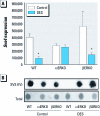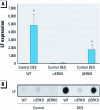Estrogen receptor-α mediates diethylstilbestrol-induced feminization of the seminal vesicle in male mice
- PMID: 22275727
- PMCID: PMC3339448
- DOI: 10.1289/ehp.1103678
Estrogen receptor-α mediates diethylstilbestrol-induced feminization of the seminal vesicle in male mice
Abstract
Background: Studies have shown that perinatal exposure to the synthetic estrogen diethylstilbestrol (DES) leads to feminization of the seminal vesicle (SV) in male mice, as illustrated by tissue hyperplasia, ectopic expression of the major estrogen-inducible uterine secretory protein lactoferrin (LF), and reduced expression of SV secretory protein IV (SVS IV).
Objectives: The present study was designed to evaluate the role of the estrogen receptor (ER) in this action by using ER-knockout (ERKO) mice.
Methods: Wild-type (WT), ERα-null (αERKO), and ERβ-null (βERKO) male mice were treated with either vehicle or DES (2 μg/day) on neonatal days 1-5. These mice were divided into two groups: In the first group, intact mice were sacrificed at 10 weeks of age; in the second group, mice were castrated at 10 weeks of age, allowed to recover for 10 days, treated with dihydrotestosterone (DHT) or placebo, and sacrificed 2 weeks later. Body weights and SV weights were recorded, and mRNA expression levels of Ltf (lactoferrin), Svs4, and androgen receptor (Ar) were assessed.
Results: In DES-treated intact mice, SV weights were reduced in WT and βERKO mice but not in αERKO mice. DES-treated WT and βERKO males, but not αERKO males, exhibited ectopic expression of LF in the SV. DES treatment resulted in decreased SVS IV protein and mRNA expression in WT males, but no effect was seen in αERKO mice. In addition, DES-treated βERKO mice exhibited reduced Svs4 mRNA expression but maintained control levels of SVS IV protein. In DES-treated castrated mice, DHT implants restored SV weights to normal levels in αERKO mice but not in WT mice, suggesting full androgen responsiveness in αERKO mice.
Conclusions: These data suggest that DES-induced SV toxicity and feminization are primarily mediated by ERα; however, some aspects of androgen response may require the action of ERβ.
Conflict of interest statement
J.F.C. is employed by Taconic Inc., Germantown, NY. The authors declare they have no actual or potential competing financial interests.
Figures





Similar articles
-
Diethylstilbestrol (DES)-stimulated hormonal toxicity is mediated by ERα alteration of target gene methylation patterns and epigenetic modifiers (DNMT3A, MBD2, and HDAC2) in the mouse seminal vesicle.Environ Health Perspect. 2014 Mar;122(3):262-8. doi: 10.1289/ehp.1307351. Epub 2013 Dec 6. Environ Health Perspect. 2014. PMID: 24316720 Free PMC article.
-
Molecular feminization of mouse seminal vesicle by prenatal exposure to diethylstilbestrol: altered expression of messenger RNA.J Urol. 1994 May;151(5):1370-8. doi: 10.1016/s0022-5347(17)35263-1. J Urol. 1994. PMID: 8158792
-
Evidence that epithelial and mesenchymal estrogen receptor-alpha mediates effects of estrogen on prostatic epithelium.Dev Biol. 2001 Jan 15;229(2):432-42. doi: 10.1006/dbio.2000.9994. Dev Biol. 2001. PMID: 11150243
-
Estrogen receptor-alpha mediates the detrimental effects of neonatal diethylstilbestrol (DES) exposure in the murine reproductive tract.Toxicology. 2004 Dec 1;205(1-2):55-63. doi: 10.1016/j.tox.2004.06.046. Toxicology. 2004. PMID: 15458790 Review.
-
Estrogenic effects on prostatic differentiation and carcinogenesis.Reprod Fertil Dev. 2001;13(4):285-96. doi: 10.1071/rd01010. Reprod Fertil Dev. 2001. PMID: 11800167 Review.
Cited by
-
Discovery of a Novel Seminal Fluid Microbiome and Influence of Estrogen Receptor Alpha Genetic Status.Sci Rep. 2016 Mar 14;6:23027. doi: 10.1038/srep23027. Sci Rep. 2016. PMID: 26971397 Free PMC article.
-
Changes in expression levels of oxidative stress-related genes in mouse epididymides by neonatal exposure to low-dose decabromodiphenyl ether.Reprod Med Biol. 2013 Dec 31;13(3):127-134. doi: 10.1007/s12522-013-0173-x. eCollection 2014 Jul. Reprod Med Biol. 2013. PMID: 29699156 Free PMC article. Review.
-
Ex vivo development of the entire mouse fetal reproductive tract by using microdissection and membrane-based organ culture techniques.Differentiation. 2022 Jan-Feb;123:42-49. doi: 10.1016/j.diff.2022.01.001. Epub 2022 Jan 6. Differentiation. 2022. PMID: 35030420 Free PMC article.
-
Estrogens and development of the rete testis, efferent ductules, epididymis and vas deferens.Differentiation. 2021 Mar-Apr;118:41-71. doi: 10.1016/j.diff.2020.11.004. Epub 2020 Dec 13. Differentiation. 2021. PMID: 33441255 Free PMC article.
-
Diethylstilbestrol (DES)-stimulated hormonal toxicity is mediated by ERα alteration of target gene methylation patterns and epigenetic modifiers (DNMT3A, MBD2, and HDAC2) in the mouse seminal vesicle.Environ Health Perspect. 2014 Mar;122(3):262-8. doi: 10.1289/ehp.1307351. Epub 2013 Dec 6. Environ Health Perspect. 2014. PMID: 24316720 Free PMC article.
References
-
- Beckman WC, Jr, Newbold RR, Teng CT, McLachlan JA. Molecular feminization of mouse seminal vesicle by prenatal exposure to diethylstilbestrol: altered expression of messenger RNA. J Urol. 1994;151:1370–1378. - PubMed
-
- Bibbo M, Gill WB, Azizi F, Blough R, Fang VS, Rosenfield RL, et al. Follow-up study of male and female offspring of DES-exposed mothers. Obstet Gynecol. 1977;49:1–8. - PubMed
-
- Conley GR, Sant GR, Ucci AA, Mitcheson HD. Seminoma and epididymal cysts in a young man with known diethylstilbestrol exposure in utero. JAMA. 1983;249:1325–1326. - PubMed
-
- Cooke PS, Young P, Hess RA, Cunha GR. Estrogen receptor expression in developing epididymis, efferent ductules, and other male reproductive organs. Endocrinology. 1991;128:2874–2879. - PubMed
-
- Couse JF, Dixon D, Yates M, Moore AB, Ma L, Maas R, et al. Estrogen receptor-α knockout mice exhibit resistance to the developmental effects of neonatal diethylstilbestrol exposure on the female reproductive tract. Dev Biol. 2001;238:224–238. - PubMed
Publication types
MeSH terms
Substances
Grants and funding
LinkOut - more resources
Full Text Sources
Research Materials
Miscellaneous

